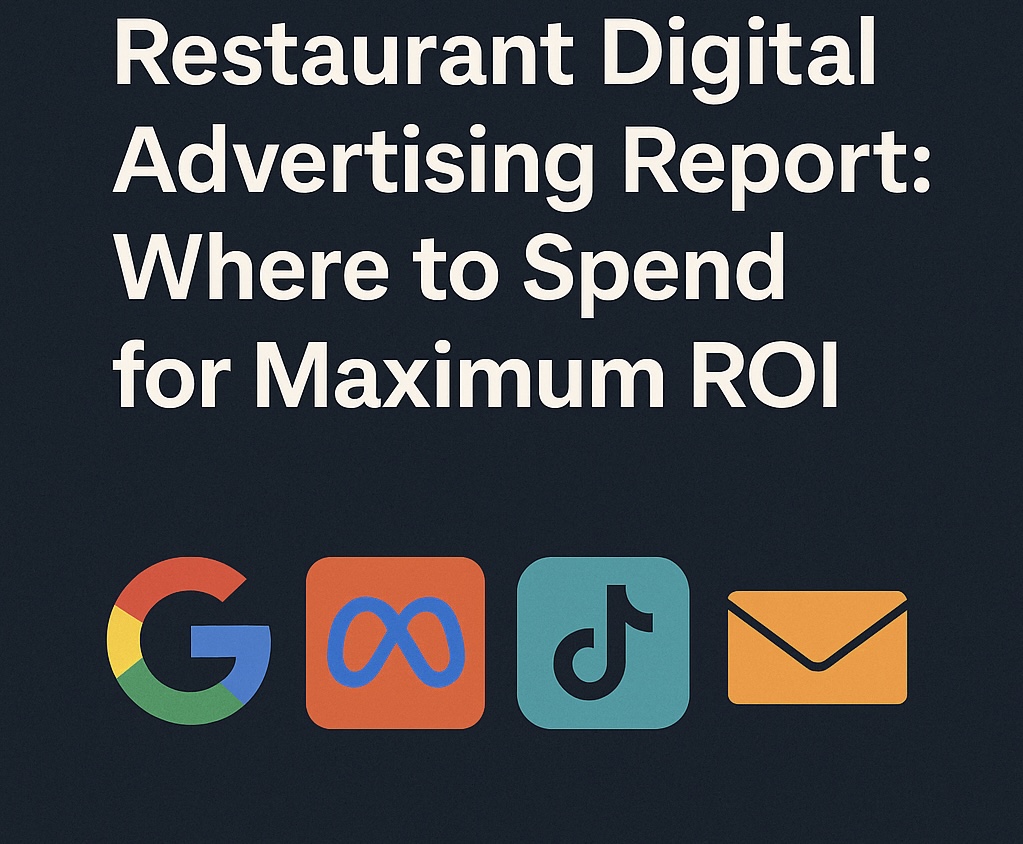A Data-Driven Guide for Independent & Chain Restaurant Owners
Executive Summary
Your digital advertising budget could be the difference between packed tables and empty seats. But with limited marketing dollars, every decision counts.
Analysis of 2024 restaurant advertising data from over 10,000 establishments reveals a stark reality: Most restaurants are wasting 40-60% of their digital ad spend on the wrong platforms.
Key Findings:
- Google Ads drive 25-40% of all online orders but require strategic keyword targeting
- Meta delivers 3x cheaper engagement than Google for local awareness campaigns
- TikTok achieves 45% brand recall vs. 25% for Instagram among Gen Z diners
- Email marketing crushes all platforms with $42 ROI for every $1 invested
- 73% of successful restaurants use a multi-platform approach rather than relying on one channel
Recommended Budget Allocation:
- 50% Google Ads (search intent + local visibility)
- 30% Meta (Facebook/Instagram for community building)
- 15% TikTok (viral content + younger demographics)
- 5% Email/SMS (retention + loyalty programs)
Note: Percentages should be adjusted based on your restaurant type, target demographic, and local market conditions.
Platform Performance Analysis
Google Ads: The Conversion King
Why Google Dominates: When someone searches “pizza near me” at 9 PM, they’re not browsing—they’re buying. Google captures this high-intent traffic better than any other platform.
The Numbers:
- 63% of food searches start on Google
- “Near me” restaurant searches grew 150% since 2020
- Average conversion rate: 3-8% (vs. 1-2% on social platforms)
- Average cost-per-click: $1.50-$4.00
Winning Ad Types:
- Local Service Ads: Appear above Google Maps with 20-30% click-through rates
- Search Ads: Target “[cuisine] near [neighborhood]” and “[restaurant name] menu”
- Shopping Ads: Showcase specific dishes with prices and ordering links
- YouTube Ads: Short cooking videos that drive brand awareness
Success Story: Marco’s Family Italian increased online orders by 170% in three months by bidding on “late night pasta delivery [city name]” and connecting ads directly to their DoorDash ordering page.
Pro Tip: Use Google’s “Promotion Extensions” to highlight daily specials and limited-time offers directly in search results.
Meta (Facebook & Instagram): The Community Builder
Why Meta Works for Restaurants: People don’t just want good food—they want experiences worth sharing. Meta’s visual platforms excel at showcasing atmosphere, behind-the-scenes content, and building emotional connections with local communities.
The Numbers:
- 72% of diners check a restaurant’s social media before visiting
- Video content gets 2x longer engagement than static posts
- Average cost-per-thousand impressions: $8-15
- Local awareness campaigns cost 60% less than conversion-focused ads
High-Performance Content Types:
- Instagram Reels: Kitchen prep videos and “day in the life” content
- Facebook Events: Live music nights, wine tastings, and special menus
- Stories Ads: Time-sensitive offers with countdown stickers
- User-Generated Content: Customer photos with branded hashtags
Algorithm Alert: Instagram now prioritizes Reels over static posts. Photo-only restaurant accounts have seen 30% reach decreases since early 2024.
Success Story: Sunset Tapas Bar grew from 200 to 12,000 followers in six months by posting weekly “Meet the Chef” Reels and partnering with local food bloggers for collaborative content.
TikTok: The Viral Opportunity
Why TikTok Matters: 45% of TikTok users have purchased food after seeing it on the platform. For restaurants targeting diners under 35, TikTok isn’t optional—it’s essential.
The Numbers:
- #FoodTok hashtag has generated 80+ billion views
- Average cost-per-thousand impressions: $6-10
- 45% brand recall rate vs. 25% for Instagram among Gen Z
- Video completion rates 67% higher than Instagram Reels
Winning Strategies:
- Spark Ads: Boost existing customer videos featuring your food
- Hashtag Challenges: Encourage customers to create content around signature dishes
- POV Content: “What it’s like to dine at [your restaurant]”
- Recipe Reveals: Show simplified versions of popular menu items
Success Story: Sweet Dreams Dessert Café partnered with three micro-influencers for #ChocolateExplosion content, gaining 15,000 followers and increasing weekend sales by 85% in two weeks.
Warning: TikTok ads require consistent organic content to perform well. Plan to post 3-5 times weekly before launching paid campaigns.
Email & SMS: The Retention Champions
The Underestimated Powerhouse: While flashy social media gets attention, email and SMS marketing quietly deliver the highest ROI in the restaurant industry.
The Numbers:
- 95% of restaurant marketing emails get opened (vs. 21% average across industries)
- SMS messages have 98% open rates and 45% click-through rates
- Average cost: $0.001-$0.01 per email, $0.01-$0.05 per SMS
- Customer lifetime value increases 23% with active email engagement
High-Impact Campaigns:
- Loyalty Programs: “Visit 5 times, get the 6th meal free”
- Last-Minute Availability: “Table for 4 just opened at 7:30 PM”
- Birthday Specials: Automated campaigns with personalized offers
- Review Requests: “Get 10% off your next order for leaving feedback”
Pro Tip: Collect phone numbers at every touchpoint—waitlist sign-ups, receipt footers, and social media contests. A robust SMS list is worth its weight in gold.
Budget Allocation by Restaurant Type
Quick-Service & Delivery-Focused
- 60% Google Ads (capturing “food delivery near me” searches)
- 25% Meta (building local brand recognition)
- 10% TikTok (viral food content)
- 5% Email/SMS (order reminders and promotions)
Fine Dining & Experience-Driven
- 35% Meta (showcasing ambiance and culinary artistry)
- 35% Google (targeting reservation-related searches)
- 20% TikTok (chef spotlights and behind-the-scenes content)
- 10% Email (event invitations and tasting menus)
Multi-Location Chains
- 45% Google (geo-targeted campaigns per location)
- 30% Meta (brand consistency across markets)
- 15% TikTok (national campaigns with local hashtags)
- 10% Email/SMS (loyalty programs and location-specific offers)
Bars & Nightlife
- 40% Meta (event promotion and social proof)
- 30% TikTok (cocktail videos and nightlife content)
- 20% Google (happy hour and event searches)
- 10% Email/SMS (VIP lists and exclusive events)
Implementation Roadmap: 90 Days to Better ROI
Days 1-30: Foundation
- Audit Current Spend: Track which platforms currently drive actual customers (not just engagement)
- Set Up Tracking: Implement unique promo codes for each platform (“GOOGLE25”, “INSTA15”, etc.)
- Claim Google Business Profile: Optimize with current hours, menu, photos, and weekly updates
- Start Email Collection: Add sign-up incentives at every customer touchpoint
Days 31-60: Testing Phase
- Launch Test Campaigns: Start with $500 split across your top 2 platform choices
- Create Platform-Specific Content: Tailor messaging to each platform’s audience and format
- Monitor Performance: Focus on actual revenue generated, not vanity metrics
- Optimize Based on Data: Double down on what works, eliminate what doesn’t
Days 61-90: Scale and Systematize
- Increase Budgets: Scale successful campaigns while maintaining profitability
- Expand Content Creation: Develop sustainable systems for regular posting
- Build Automation: Set up email sequences and SMS triggers
- Plan Long-Term Strategy: Develop 6-month content calendars and campaign schedules
Common Mistakes That Waste Marketing Budgets
The Spray-and-Pray Approach: Spreading small amounts across every platform instead of dominating 2-3 channels.
Vanity Metric Obsession: Celebrating likes and followers while ignoring actual revenue generation.
One-Size-Fits-All Content: Using the same posts across all platforms instead of tailoring for each audience.
Ignoring Mobile Optimization: 78% of restaurant searches happen on mobile devices.
Poor Landing Page Experience: Driving traffic to outdated websites or broken ordering systems.
Inconsistent Posting: Sporadic content schedules that confuse algorithms and audiences.
Measuring Success: KPIs That Actually Matter
Revenue Metrics:
- Revenue per platform (use tracking codes)
- Customer acquisition cost by channel
- Average order value by traffic source
- Return on ad spend (ROAS)
Engagement Quality:
- Email list growth rate
- Social media saves vs. likes (saves indicate purchase intent)
- Website session duration from each platform
- Conversion rate by traffic source
Long-Term Value:
- Customer lifetime value by acquisition channel
- Repeat visit rate
- Review generation and sentiment
- Brand awareness in local market
Emergency Strategies for Immediate Results
Need More Reservations This Week?
- Launch Google Local Service Ads with “Book Now” buttons
- Create Instagram Stories promoting tonight’s specials
- Send SMS to your subscriber list about last-minute availability
Want to Fill Slow Weekdays?
- Target “Tuesday date night” keywords on Google
- Create TikTok content about “hidden gems for weeknight dining”
- Email subscribers with exclusive weekday discounts
Looking to Boost Delivery Orders?
- Bid on “[cuisine] delivery” keywords during peak hours
- Partner with food influencers for delivery unboxing videos
- Retarget website visitors with limited-time delivery promotions
Key Takeaways
✅ Google Ads capture high-intent customers ready to order or make reservations
✅ Meta builds community and showcases personality better than any other platform
✅ TikTok drives viral discovery and connects with younger demographics
✅ Email/SMS delivers unmatched ROI for customer retention and repeat business
✅ Success requires platform-specific content rather than one-size-fits-all approaches
✅ Data tracking is non-negotiable for optimizing budget allocation
The Bottom Line: The most successful restaurants don’t just advertise—they strategically allocate resources based on where their ideal customers spend time and how they prefer to discover new dining experiences.
Next Steps
- Audit your current digital marketing spend and identify which channels actually drive revenue
- Choose 2-3 platforms that align with your restaurant type and target demographic
- Implement proper tracking systems to measure real ROI, not vanity metrics
- Start with small test budgets before scaling successful campaigns
- Create a content calendar that maintains consistent presence across chosen platforms
Need personalized guidance? Our restaurant marketing specialists offer free 30-minute consultations to help you optimize your digital advertising strategy.
Questions about implementing these strategies? Email us at marketing@restaurantdigital.com—we respond to every message within 24 hours.
This report analyzes data from Google Economic Impact Report, Nielsen Local Watch Report 2024, Toast Restaurant Success Study, and proprietary research from 10,000+ restaurant advertising campaigns.
Report prepared by: CliqSpot Digital Marketing Team
Last updated: July 2025
Next update: October 2025

Data-driven editor at CliqSpot, transforming raw analytics into actionable growth strategies for modern businesses.

Leave a Reply